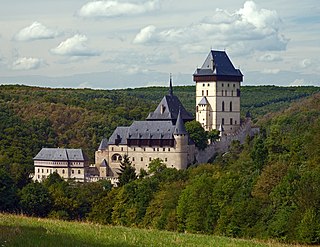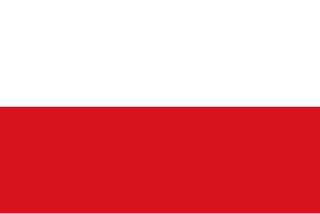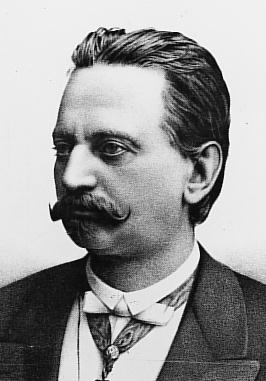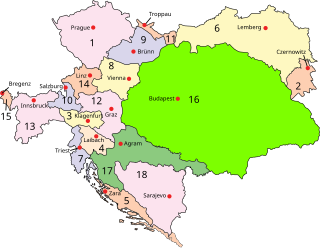
Austria-Hungary, also referred to as the Austro-Hungarian Empire or the Dual Monarchy, was a multi-national constitutional monarchy in Central Europe between 1867 and 1918. A military and diplomatic alliance, it consisted of two sovereign states with a single monarch who was titled both Emperor of Austria and King of Hungary. Austria-Hungary constituted the last phase in the constitutional evolution of the Habsburg monarchy: it was formed with the Austro-Hungarian Compromise of 1867 in the aftermath of the Austro-Prussian War and was dissolved shortly after Hungary terminated the union with Austria on 31 October 1918.

Bohemia is the westernmost and largest historical region of the Czech Republic. Bohemia can also refer to a wider area consisting of the historical Lands of the Bohemian Crown ruled by the Bohemian kings, including Moravia and Czech Silesia, in which case the smaller region is referred to as Bohemia proper as a means of distinction.
The history of the Czech lands – an area roughly corresponding to the present-day Czech Republic – starts approximately 800 years BCE. A simple chopper from that age was discovered at the Red Hill archeological site in Brno. Many different primitive cultures left their traces throughout the Stone Age, which lasted approximately until 2000 BCE. The most widely known culture present in the Czech lands during the pre-historical era is the Únětice Culture, leaving traces for about five centuries from the end of the Stone Age to the start of the Bronze Age. Celts – who came during the 5th century BCE – are the first people known by name. One of the Celtic tribes were the Boii (plural), who gave the Czech lands their first name Boiohaemum – Latin for the Land of Boii. Before the beginning of the Common Era the Celts were mostly pushed out by Germanic tribes. The most notable of those tribes were the Marcomanni and traces of their wars with the Roman Empire were left in south Moravia.

The Austro-Hungarian Compromise of 1867 established the dual monarchy of Austria-Hungary, which was a military and diplomatic alliance of two sovereign states. The Compromise only partially re-established the former pre-1848 sovereignty and status of the Kingdom of Hungary, being separate from, and no longer subject to, the Austrian Empire. The compromise put an end to the 18-year-long military dictatorship and absolutist rule over Hungary which Emperor Franz Joseph had instituted after the Hungarian Revolution of 1848. The territorial integrity of the Kingdom of Hungary was restored. The agreement also restored the old historic constitution of the Kingdom of Hungary.

Cisleithania, officially The Kingdoms and Lands Represented in the Imperial Council, was the northern and western part of Austria-Hungary, the Dual Monarchy created in the Compromise of 1867—as distinguished from Transleithania. This name for the region was a common, but unofficial one.
The creation of Czechoslovakia in 1918 was the culmination of the long struggle of the Czechs against their Austrian rulers and of the Slovaks against Magyarization and their Hungarian rulers.

The Czech lands, then also known as Lands of the Bohemian Crown, were largely subject to the Habsburgs from the end of the Thirty Years' War in 1648 until the Austro-Hungarian Compromise of 1867. There were invasions by the Turks early in the period, and by the Prussians in the next century. The Habsburgs consolidated their rule and under Maria Theresa (1740–1780) adopted enlightened absolutism, with distinct institutions of the Bohemian Kingdom absorbed into centralized structures. After the Napoleonic Wars and the establishment of the Austrian Empire, a Czech National Revival began as a scholarly trend among educated Czechs, led by figures such as František Palacký. Czech nationalism took a more politically active form during the 1848 revolution, and began to come into conflict not only with the Habsburgs but with emerging German nationalism.

Georg Ritter von Schönerer was an Austrian landowner and politician of Austria-Hungary active in the late 19th and early 20th centuries. A major exponent of pan-Germanism and German nationalism in Austria as well as a radical opponent of political Catholicism and a fierce antisemite, Schönerer exerted much influence on the young Adolf Hitler. He was known for a generation as the most radical pan-German nationalist in Austria.

Karel Kramář was a Czech politician. He was a representative of the major Czech political party, the Young Czechs, in the Austrian Imperial Council from 1891 to 1915, becoming the party leader in 1897.

Eduard Franz Joseph Graf von Taaffe, 11th Viscount Taaffe was an Austrian statesman, who served for two terms as Minister-President of Cisleithania, leading cabinets from 1868 to 1870 and 1879 to 1893. He was a scion of the Irish Taaffe noble dynasty, who held hereditary titles from two countries: Imperial Counts (Reichsgrafen) of the Holy Roman Empire and viscounts in the Peerage of Ireland.

German Bohemians, later known as Sudeten Germans, were ethnic Germans living in the Czech lands of the Bohemian Crown, which later became an integral part of Czechoslovakia. Before 1945, over three million German Bohemians constituted about 23% of the population of the whole country and about 29.5% of the population of Bohemia and Moravia. Ethnic Germans migrated into the Kingdom of Bohemia, an electoral territory of the Holy Roman Empire, from the 11th century, mostly in the border regions of what was later called the "Sudetenland", which was named after the Sudeten Mountains.

The United States of Greater Austria was an unrealised proposal made in 1906 to federalize Austria-Hungary to help resolve widespread ethnic and nationalist tensions. It was conceived by a group of scholars surrounding Archduke Franz Ferdinand of Austria, notably by the ethnic Romanian lawyer and politician Aurel Popovici.

Austrian Silesia, officially the Duchy of Upper and Lower Silesia, was an autonomous region of the Kingdom of Bohemia and the Habsburg monarchy. It is largely coterminous with the present-day region of Czech Silesia and was, historically, part of the larger Silesia region.

Count Karl Sigmund von Hohenwart was an Austrian politician who served as Minister-President of Austria in 1871. Hohenwart’s government attempted to implement a Federalist agreement between Bohemia and the governing Austro-Hungarian Empire. This attempt to conciliate the Bohemian Czechs caused massive criticism, and led to the fall of the Hohenwart government only months after it assumed office.
The Fundamental Articles of 1871 were a set of proposed changes to the Austro-Hungarian constitution regarding the status of the Bohemian Crownlands. Their rejection was largely responsible for the downfall of the Hohenwart cabinet.

The Young Czech Party was formed in the Bohemian crown land of Austria-Hungary in 1874. It initiated the democratization of Czech political parties and led to the establishment of the political base of Czechoslovakia.
The history of Czechoslovak nationality involves the rise and fall of national feeling among Czechs and Slovaks. Once forming a rather unified group, they were historically separated, unified under a democratic system, separated during threat of war, and reunified under a socialist authoritarian regime. However, a democratization process has led to a definition of separate statehood for the majority of Czechs and Slovaks.

Neighborly relations exist between Austria and the Czech Republic, two member states of the European Union. Austria gave full support to the Czech Republic's membership of the European Union. The Czech Republic is a member state of NATO, while Austria is not.

The dissolution of Austria-Hungary was a major geopolitical event that occurred as a result of the growth of internal social contradictions and the separation of different parts of Austria-Hungary. The more immediate reasons for the collapse of the state were World War I, the 1918 crop failure, general starvation and the economic crisis. The Austro-Hungarian Empire had additionally been weakened over time by a widening gap between Hungarian and Austrian interests. Furthermore, a history of chronic overcommitment rooted in the 1815 Congress of Vienna in which Metternich pledged Austria to fulfill a role that necessitated unwavering Austrian strength and resulted in overextension. Upon this weakened foundation, additional stressors during World War I catalyzed the collapse of the empire. The 1917 October Revolution and the Wilsonian peace pronouncements from January 1918 onward encouraged socialism on the one hand, and nationalism on the other, or alternatively a combination of both tendencies, among all peoples of the Habsburg monarchy.

The Old Czech Party was formed in the Kingdom of Bohemia and Bohemian Crown Lands of Austrian Empire in Revolution Year of 1848. They initiated Czech national program, forming of modern national through Czech National Revival and better position of Bohemia within the Habsburg Monarchy.



















